INFORMATION ALSO AVAILABLE IN ENGLISH, GUJARATI AND HINDI
There are two types of swellings in the neck:
Congenital Swellings (Since Birth):
a) Tyroglossal Cyst: This swelling occurs in the midline of the neck and is due to a developmental defect during the formation of the thyroid gland. Surgery is a must for this swelling.
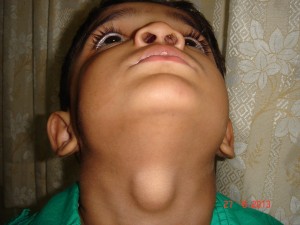 Thyroglossal Cyst
Thyroglossal Cyst
b) Dermoid Cyst: This swelling also happens in the midline of the neck. They are also seen at many other sites in the body. Surgery is also required for these swellings.
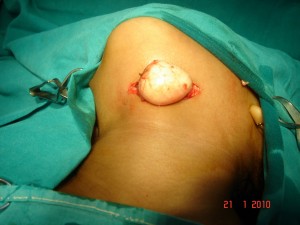 Dermoid Cyst
Dermoid Cyst
c) Cystic Hygroma: These swellings occur as a result of a developmental anomaly of the lymphatics. They look like cysts filled with water and are commonly seen in any part of the neck. They can vary from being very small to massive in size. Surgery is curative for these swellings.
 Cystic Hygroma in the neck
Cystic Hygroma in the neck
d) Branchial cyst: These swellings are found on the side of the neck. They are sometimes also seen like a small punctum which is called a Branchial Sinus
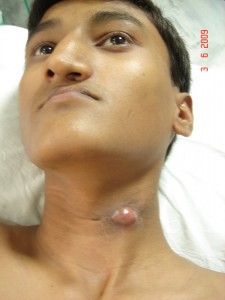 Branchial Cyst in the neck
Branchial Cyst in the neck
e) Cervical Meningocele: These swellings are seen behind the neck in the midline. They are present since birth and surgery is curative.
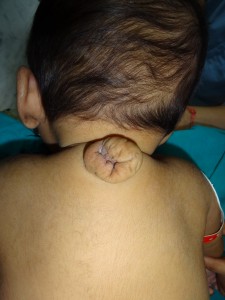 Cervical Meningomyelocele
Cervical Meningomyelocele
Acquired Swellings (After Birth) :
a) Lymph nodes: They can be single or multiple. They may be seen over different sites in the neck. Common cause of lymph node enlargement is secondary to an infective process in the head and neck region.
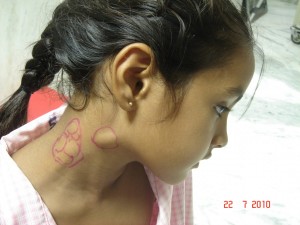
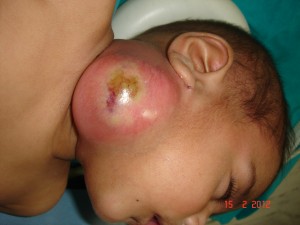
b) Tuberculous nodes (Koch’s nodes): Tuberculous nodes are not uncommon. A confirmed diagnosis can be acheived by biopsy of the node. Regular medications can almost always cure this problem.
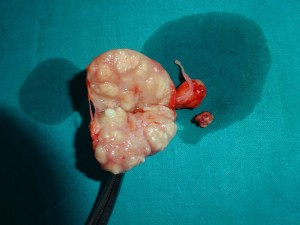
c) Malignant nodes (Cancers): The most commonly seen malignant nodes in the neck in children are lymphomas. Confirmation of diagnosis can be done by biopsy of the nodes. Regular chemotherapy can be curative in most of these cases.
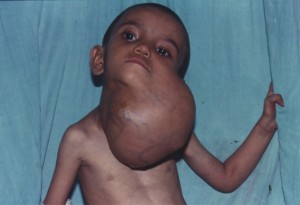
Lymph Glands in the Neck:
Everyone has lymph glands. They are in many areas of the body, including the neck, under the arms and in the groin (at the top of each leg). There are also lymph glands in the abdomen, chest and pelvis. Lymph glands are also known as lymph nodes.
Lymph glands become enlarged when the body is fighting an infection, such as a cold. Enlarged lymph glands are particularly common in children as their body takes time to build up immunity to infection.
What causes swollen lymph glands?
Lymph glands swell as part of the body’s response to infection.
Lymph glands are connected by vessels with branches right through the body, similar to the blood circulation system. Rather than carrying blood, these vessels carry a clear liquid called lymph, which contains a high number of white blood cells.
Together with other organs (the spleen, tonsils, adenoids and thymus gland), they form what’s known as the lymphatic system. It has several functions but one of its key roles is fighting infection.
When the body is fighting an infection, the number of white blood cells multiplies rapidly. Some of these cells will go to the lymph gland nearest the infection, which produces enlargement of the lymph glands.
Children often have infections as it takes time for them to build immunity to the viruses and bacteria in the environment. Children who have recently started playgroup or nursery are especially prone because they are coming into contact with a large group of children of the first time.
What are the signs and symptoms of enlarged lymph glands?
The lymph glands will appear swollen. They will also be uncomfortable.
Children frequently get upper respiratory tract infections, such as an ear or throat infection. This means that swollen glands in the neck are particularly common.
How are enlarged lymph glands normally diagnosed?
A child’s doctor will feel their glands to check if they are swollen.
How are enlarged lymph glands treated?
Most cases of enlarged lymph glands are from infection. Once the infection is gone, the glands will get smaller and less tender over time.
If the glands are particularly large, the doctor will check the child for any other symptoms or an underlying cause.
What happens next?
In most cases, enlarged lymph glands are not serious and the condition is common. Following an infection, it is normal for them to take some time for the swelling to go down.
Enlarged lymph glands rarely indicate a more serious problem. Sometimes it is a sign of cancer, such as lymphoma, but this is rare.
GUJARATI
ગળામાં થતી ગાંઠો
ગળામાં થતી ગાંઠો બે પ્રકારની હોય છેઃ
૧. જન્મ જાત ગાંઠઃ
૧) થાઇરોગ્લોસલ સીસ્ટ : ગળાનાં મધ્ય ભાગમાં થતી ગાંઠ થાયરોઇડ ગ્રંથિની ડેવલપમેન્ટની ક્ષતિના કારણે થાય છે. આૅપરેશન કરવાથી જ મટે છે.
૨) ડરમોઈડ સીસ્ટ : આ પણ ગળાનાં મધ્યભાગમાં થતી ગાંઠ છે. જે ઓપરેશનથી મટે છે.
૩) સીસ્ટીક હાઇગ્રોમા : લીમ્ફેટીક નળીઓની બનાવટની ખામીના કારણે, પાણી ભરેલી ગાંઠ ગળામાં ગમે તે જગ્યાએ થાય છે. આવી ગાંઠ સાઈઝમાં નાની અથવા આત્યંત મોટી હોય છે. યોગ્ય સમયે ઓપરેશન કરાવવું જરૂરી છે.
૪) બ્રેન્કયલ સીસ્ટ : આ ગાંઠ ગળાની સાઈડમાં જાવા મળતી હોય છે. ધણીવાર તે નાના છિદ્રનાં રૂપમાં હોય છે. (જેને સાઇનસ કહે છે.)
૫) સરવાઇકલ મેનીન્ગોમાઇલોસીલ : ગળાની પાછળ બરાબર કરોડના મણકા પર થતી જન્મજાત ગાંઠ છે અને આૅપરેશન કરવાથી સંપૂર્ણ સા૨ું થઈ જાય છે.
૨. જન્મ પછી થતી ગળાની ગાંઠો :
૧) લીમ્ફનોડની ગાંઠ : આ ગાંઠ ગળામાં જાવા મળે છે અને તે એક કરતા વધુની સંખ્યામાં અને જુદી જુદી જગ્યાએ પણ હોય છે.
લીમ્ફગ્લેન્ડ – માથા, નાક, કાન, ગળામાં થતા ઇન્ફેક્શનની વેડ ઘાલવાથી થાય છે અને બરાબર દવા કરવાથી મટે છે.
૨) ટી.બી.ની ગાંઠ : ગળામાં ટી.બી.ની ગાંઠ ૧/૨ણી સામાન્ય બીમારી છે. ચોક્કસ નિદાન બાયોપ્સી દ્બા૨ા કરાવી યોગ્ય દવાઓ આપવાથી મટી જાય છે.
૩) કેન્સરની ગાંઠ : બાળકોમાં ગળામાં લીમ્ફોમા નામના કેન્સરને લીધે ગાંઠ થતી હોય છે. તેનું જરૂરી નિદાન બાયોપ્સી વડે કરાવી, દવાઓથી મટાડી શકાય છે. •
HINDI
गले की गांठे
१. जन्मजात गांठ
१) थाइरोग्लोसल सीस्टः गले के मध्य भाग में होनेवाली यह गांठ थाइरोइड ग्ा्रंथी के दोषपूर्ण विकास के कारण होती है और यह केवल ऑपरेशन के द्वारा ही ठीक की जा सकती है।
२) डरमोइड सीस्टः यह भी गले के मध्य भाग में होनेवाली एक गांठ है जो ऑपरेशन के द्वारा ही ठीक की जा सकती है।
३) सीस्टिक हाइग्ा्रोमाः लीम्फेटिक नलिकाओं की बनावट में दोष के कारण, पानी भरी एक गांठ गले के भीतर कहीं भी हो सकती है। यह गांठ आकार में या तो अत्यंत छोटी होती है या अत्यंत बड़ी होती है। उचित समय पर इसका ऑपरेशन कराना आवश्यक है।
४) ब्रेंकीयल सीस्टः यह गले के एक ओर दिखाई देनेबाली गांठ है। कई बार यह एक छोटे से छेद के रूप में होती है (जिसे साइनस कहते हैं)।
५) सरवाइकल मेनींगोमाइलोसीलः गरदन के पिछले हिस्से में ठीक रीढ़ पर होनेवाली जन्मजात गांठ होती है और ऑपरेशन के द्वारा पूर्णरूप से ठीक हो जाती है।
२. जन्म के बाद होनेवाली गले की गांठ
१) लीम्फनोड की गांठः इस प्रकार की गांठ गले के एक ओर देखी जा सकती है।
२) टी.बी. की गांठः गले में टी.बी. की गांठ होना एक सामान्य बीमारी है। सही निदान, बायोप्सी के उपरांत उचित दवाइयों से ठीक हो जाती है।
३) कैंसर की गांठः यह बच्चों के गले में लीम्फोमा नामक कैंसर के कारण होनेवाली गांठ है। इसे आवश्यक निदान, बायोप्सी तथा उचित दवाइयों से ठीक किया जा सकता है।•




